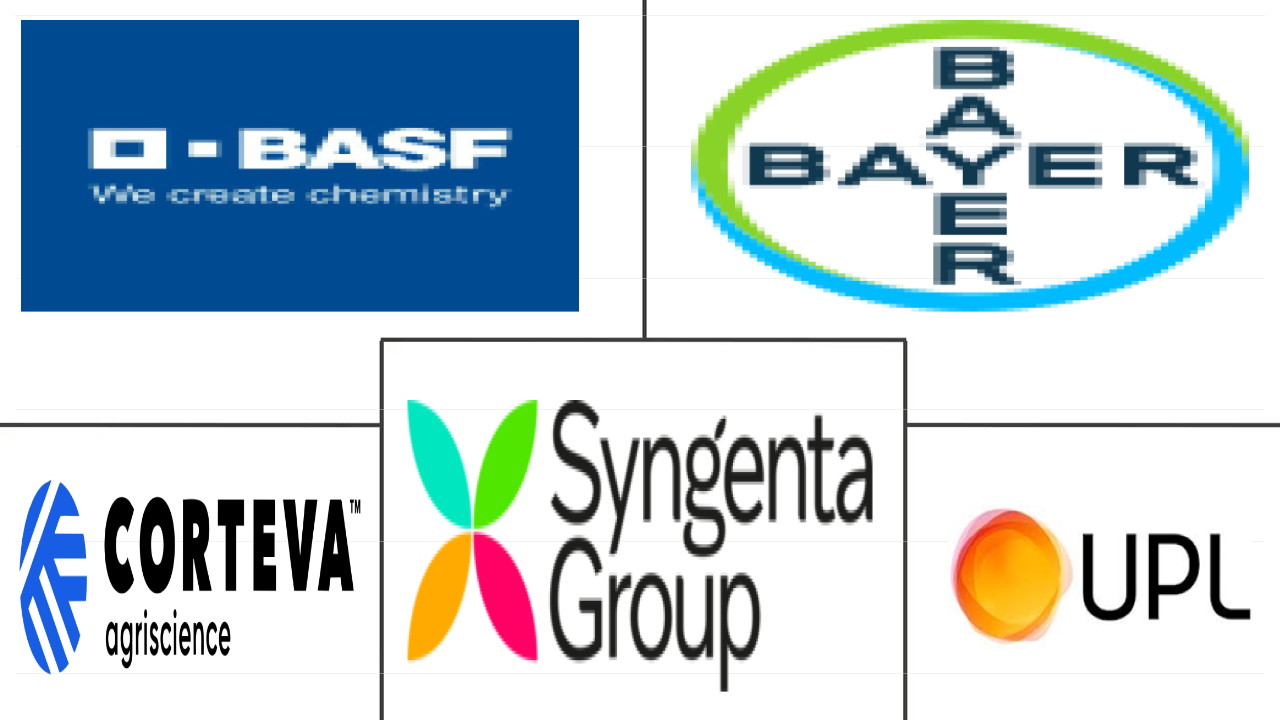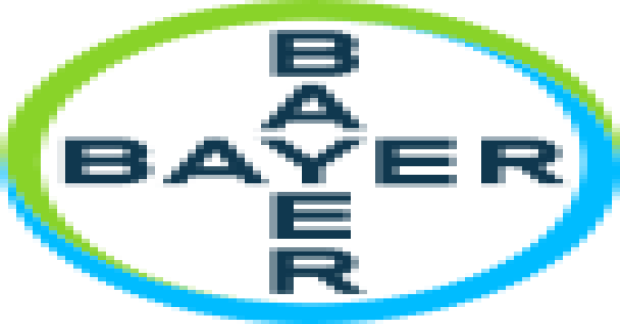Market Size of south america fungicide Industry
|
|
Study Period | 2017 - 2029 |
|
|
Market Size (2024) | USD 5.32 Billion |
|
|
Market Size (2029) | USD 6.5 Billion |
|
|
Largest Share by Application Mode | Foliar |
|
|
CAGR (2024 - 2029) | 4.07 % |
|
|
Largest Share by Country | Brazil |
Major Players |
||

|
||
|
*Disclaimer: Major Players sorted in no particular order |
South America Fungicide Market Analysis
The South America Fungicide Market size is estimated at 5.32 billion USD in 2024, and is expected to reach 6.5 billion USD by 2029, growing at a CAGR of 4.07% during the forecast period (2024-2029).
5.32 Billion
Market Size in 2024 (USD)
6.5 Billion
Market Size in 2029 (USD)
10.12 %
CAGR (2017-2023)
4.07 %
CAGR (2024-2029)
Largest Segment by Application Mode
58.74 %
value share, Foliar, 2023
Foliar fungicides are often preferred due to their cost-effectiveness, targeted approach, and efficient absorption, which contribute to cost-effective disease control.
Largest Segment by Crop Type
42.10 %
value share, Pulses & Oilseeds, 2023
Soybean is a major oilseed crop in countries like Brazil, Argentina, Paraguay, and Uruguay and is more susceptible to fungal diseases. Hence, it needs fungicide applications.
Largest Segment By Country
59.41 %
value share, Brazil, 2023
Continuous expansion and diversification of agriculture in Brazil have increased the threat of fungal diseases, which can adversely impact crops, leading to yield losses.
Leading Market Player 1
29.16 %
market share, Syngenta Group, 2022

The company launched TYMIRIUM® technology, a low-dose active ingredient, to combat nematodes and soil-borne and seed-borne fungal diseases through seed treatments.
Leading Market Player 2
18.01 %
market share, Bayer AG, 2022

Bayer's acquisitions and partnerships with companies like Monsanto and Oerth Bio enhanced the product portfolio offered in the country, boosting the company's growth in the market.
The foliar application holds the utmost significance as the primary mode of fungicide application
- In South America, numerous methods of fungicide applications are utilized to effectively control fungal diseases in agriculture. By choosing suitable application methods, farmers can attain cost-efficient solutions, ensuring accurate coverage of specific areas and minimizing unnecessary usage. This improved efficacy optimizes fungicide utilization, resulting in decreased input costs for farmers.
- Among various fungicide application methods in agriculture, foliar application is the dominant mode, accounting for 58.7% of the total fungicide usage in 2022. This approach is primarily utilized in pulses and oilseeds, which hold the largest market share at 41.7%. The targeted and efficient absorption properties of foliar application contribute to its effectiveness in controlling diseases, potentially resulting in increased yields and saving costs for farmers.
- In 2022, the seed treatment method held the second-largest market share, comprising 14.5% of the total. The rise in farmers' awareness about the benefits of using fungicide seed treatment products to protect seedlings and boost productivity has resulted in a significant rise in their adoption. As a result, it is projected that the South American fungicide seed treatment market may experience a CAGR of 4.04% during the forecast period from 2023 to 2029.
- In the agricultural sector of South America, fungicides are utilized with the primary aim of maximizing crop yields and improving overall profitability. The mode of the application segment is anticipated to experience substantial growth, with a CAGR of 4.0% during the forecast period from 2023 to 2029.
Brazil dominated the market as the threat of fungal diseases to crops became increasingly significant
- Many crops thrive in the tropical climates of South America. Brazil, Argentina, and Paraguay are the three major agricultural producers in South America. These countries are major exporters of soybeans, maize, sugar, coffee, fruits, and vegetables.
- Brazil dominated the market, accounting for a market share of 59.4% in 2022. As Brazil's agriculture expands and diversifies, the threat of fungal diseases to crops becomes increasingly significant. Fungal pathogens can adversely impact a wide range of crops, leading to yield losses, reduced quality, and economic losses for farmers.
- Chile accounted for 4.8% of the South American fungicide market in 2022. Chile has a temperate climate in the Atacama Desert in the north, a Mediterranean climate in the central and fertile central valley region, and a cool and damp climate in the southern low coastal mountains and rugged Andes in the east. These climatic conditions favor the proliferation of fungal diseases in the country. Captan and thiram are two fungicides widely used in Chile. Captan is found to have the greatest interaction with natural soils with high organic matter content, while thiram showed a preference for soils with high clay content.
- Factors driving the market for fungicides include decreasing arable land, increasing population, and the need to improve crop yields. Resistance of various fungi to the existing fungicides and the emergence of new diseases in plants led the companies to find novel products for fighting the new fungus mutations and reducing the loss to farmers. The increasing demand for fungicides to fight crop diseases is expected to drive the market during the forecast period.
South America Fungicide Industry Segmentation
Chemigation, Foliar, Fumigation, Seed Treatment, Soil Treatment are covered as segments by Application Mode. Commercial Crops, Fruits & Vegetables, Grains & Cereals, Pulses & Oilseeds, Turf & Ornamental are covered as segments by Crop Type. Argentina, Brazil, Chile are covered as segments by Country.
- In South America, numerous methods of fungicide applications are utilized to effectively control fungal diseases in agriculture. By choosing suitable application methods, farmers can attain cost-efficient solutions, ensuring accurate coverage of specific areas and minimizing unnecessary usage. This improved efficacy optimizes fungicide utilization, resulting in decreased input costs for farmers.
- Among various fungicide application methods in agriculture, foliar application is the dominant mode, accounting for 58.7% of the total fungicide usage in 2022. This approach is primarily utilized in pulses and oilseeds, which hold the largest market share at 41.7%. The targeted and efficient absorption properties of foliar application contribute to its effectiveness in controlling diseases, potentially resulting in increased yields and saving costs for farmers.
- In 2022, the seed treatment method held the second-largest market share, comprising 14.5% of the total. The rise in farmers' awareness about the benefits of using fungicide seed treatment products to protect seedlings and boost productivity has resulted in a significant rise in their adoption. As a result, it is projected that the South American fungicide seed treatment market may experience a CAGR of 4.04% during the forecast period from 2023 to 2029.
- In the agricultural sector of South America, fungicides are utilized with the primary aim of maximizing crop yields and improving overall profitability. The mode of the application segment is anticipated to experience substantial growth, with a CAGR of 4.0% during the forecast period from 2023 to 2029.
| Application Mode | |
| Chemigation | |
| Foliar | |
| Fumigation | |
| Seed Treatment | |
| Soil Treatment |
| Crop Type | |
| Commercial Crops | |
| Fruits & Vegetables | |
| Grains & Cereals | |
| Pulses & Oilseeds | |
| Turf & Ornamental |
| Country | |
| Argentina | |
| Brazil | |
| Chile | |
| Rest of South America |
South America Fungicide Market Size Summary
The South America fungicide market is experiencing a steady expansion, driven by the need to combat fungal diseases that threaten agricultural productivity. The market is characterized by various application methods, with foliar application being the most prevalent due to its effectiveness in targeting specific areas and optimizing fungicide use. This method is particularly dominant in the cultivation of pulses and oilseeds, which represent a significant portion of the market. Seed treatment is also gaining traction as farmers increasingly recognize its benefits in protecting seedlings and enhancing crop yields. The region's diverse climatic conditions, especially in countries like Brazil, Argentina, and Paraguay, contribute to the prevalence of fungal diseases, necessitating the use of fungicides to maintain crop health and profitability.
Brazil stands out as the leading market player, with a substantial share of fungicide consumption, driven by its expansive agricultural activities and the threat of fungal pathogens. Chile, with its unique climatic conditions, is the largest consumer of fungicides in the region, relying on these products to manage fungal diseases effectively. The market is further propelled by factors such as decreasing arable land, population growth, and the need for improved crop yields. The emergence of new fungal diseases and resistance to existing fungicides are prompting companies to innovate and develop novel solutions. Key players in the market, including BASF SE, Bayer AG, Corteva Agriscience, Syngenta Group, and UPL Limited, are actively engaged in expanding their product offerings and enhancing crop protection technologies to meet the growing demand for effective fungicide solutions in South America.
South America Fungicide Market Size - Table of Contents
-
1. MARKET SEGMENTATION (includes market size in Value in USD and Volume, Forecasts up to 2029 and analysis of growth prospects)
-
1.1 Application Mode
-
1.1.1 Chemigation
-
1.1.2 Foliar
-
1.1.3 Fumigation
-
1.1.4 Seed Treatment
-
1.1.5 Soil Treatment
-
-
1.2 Crop Type
-
1.2.1 Commercial Crops
-
1.2.2 Fruits & Vegetables
-
1.2.3 Grains & Cereals
-
1.2.4 Pulses & Oilseeds
-
1.2.5 Turf & Ornamental
-
-
1.3 Country
-
1.3.1 Argentina
-
1.3.2 Brazil
-
1.3.3 Chile
-
1.3.4 Rest of South America
-
-
South America Fungicide Market Size FAQs
How big is the South America Fungicide Market?
The South America Fungicide Market size is expected to reach USD 5.32 billion in 2024 and grow at a CAGR of 4.07% to reach USD 6.50 billion by 2029.
What is the current South America Fungicide Market size?
In 2024, the South America Fungicide Market size is expected to reach USD 5.32 billion.

